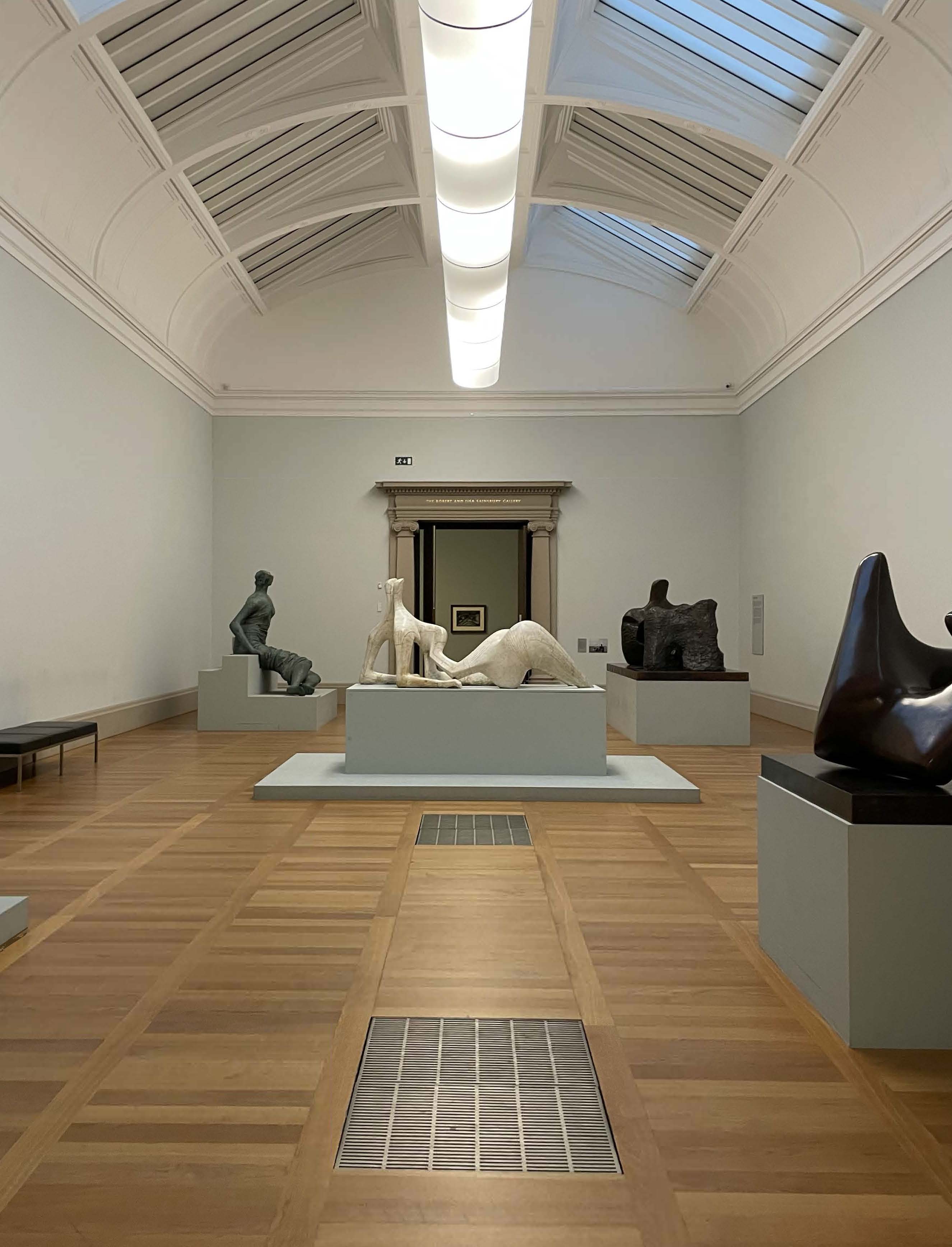ヘンリー・ムーア
イギリスが生んだブロンズの巨匠
イギリスが生んだブロンズの巨匠
Henry Moore
A legend of Bronze born in England
A legend of Bronze born in England
 1225/10/2022
His work in Tate Britain
1225/10/2022
His work in Tate Britain
ということで、今回はヘンリー・ムーアについて。誰もが一度は彼の彫刻を見たことがあるであろう。
私もTate Britainで鑑賞する前に、静岡でも箱根でも目にしたことがある(と思う)。
それほど彼の作品たちは有名で、世界中で鑑賞することができる。
私が今回気に入った作品の一つ、「reclining figure(1951)」。上の写真の真ん中に位置している作品。 これは彼の無尽蔵のテーマのうちの一つ、「横たわる像」だ。もう一つはちなみに「母と子」。 見てわかる通り無数の線が描かれていて、それらが彫刻の立体感を高めている。下に行くにつれて放線が増えて、重力を感じる。逆に滑らかな部分や膨らみがある部分は、線によってそれが強調されている。 ウェブサイトによると、1951年の英国フェスティバル?のために作られたオリジナル石膏作品らしい。もちろんブロンズの作品とかと比べると光沢感とか肌触りのツルツルさとかはあまり感じづらいんだけど、その分線や繊細さに注目がいく気がする。
 ウェブサイトのリンク
ウェブサイトのリンク
少し彼について紹介する。 彼はイギリスのヨークシャー・キャッスルフォードで炭鉱夫の息子として生まれた。 1919年にリーズ芸術学校の彫刻科の初めの生徒となり、バーバラ・ヘップワースに出会う。 彼女はのちに彼にとって生涯の彼の戦友のような存在となる人物だ。 この時期から彼はモダニズムに傾倒していくことになるが、 1921年にロンドンのロイヤルカレッジの奨学金を得てVAや大英博物館に所蔵されている民族的な多くの作品に触れることにより、 作風はビクトリア朝風のものからどんどん変化していく。 先程紹介した彼の大きなテーマ2つも、この経験に大きく影響を受けている。 例えば「母と子」は、アフリカンアートに、「横たわる像」はパリで見た古代メソアメリカの人物像に、強くインスピレーションを受けたと言われている。 さらにダイレクト・カーヴィングという直に大理石・木といった素材を切り彫りしていく制作方法を取り入れ、 「truth to materials(素材の良さを最大限に活かした制作)」と言われる。 のちにもシュルレアリズムの「無意識」に関するムーヴメントに触発されたり、公共施設のために多く作品を制作したりと、 割とずっと順風満帆に芸術家としての人生を歩んでいった。
まあ、毎回何度も言うように、気になる方は調べてみてください。 私もまたTate Britainに行って作品を見てくるよ〜ちなみにTate BritainではJohn Readという人によって撮影された制作過程の動画も見ることができる。 部品ごとに作ってくっつけるところとか、溶かして型に流し込んでいるところとか。すごく大掛かり。一見の価値あり!以上
2022/10/25
私が今回気に入った作品の一つ、「reclining figure(1951)」。上の写真の真ん中に位置している作品。 これは彼の無尽蔵のテーマのうちの一つ、「横たわる像」だ。もう一つはちなみに「母と子」。 見てわかる通り無数の線が描かれていて、それらが彫刻の立体感を高めている。下に行くにつれて放線が増えて、重力を感じる。逆に滑らかな部分や膨らみがある部分は、線によってそれが強調されている。 ウェブサイトによると、1951年の英国フェスティバル?のために作られたオリジナル石膏作品らしい。もちろんブロンズの作品とかと比べると光沢感とか肌触りのツルツルさとかはあまり感じづらいんだけど、その分線や繊細さに注目がいく気がする。
 ウェブサイトのリンク
ウェブサイトのリンク
少し彼について紹介する。 彼はイギリスのヨークシャー・キャッスルフォードで炭鉱夫の息子として生まれた。 1919年にリーズ芸術学校の彫刻科の初めの生徒となり、バーバラ・ヘップワースに出会う。 彼女はのちに彼にとって生涯の彼の戦友のような存在となる人物だ。 この時期から彼はモダニズムに傾倒していくことになるが、 1921年にロンドンのロイヤルカレッジの奨学金を得てVAや大英博物館に所蔵されている民族的な多くの作品に触れることにより、 作風はビクトリア朝風のものからどんどん変化していく。 先程紹介した彼の大きなテーマ2つも、この経験に大きく影響を受けている。 例えば「母と子」は、アフリカンアートに、「横たわる像」はパリで見た古代メソアメリカの人物像に、強くインスピレーションを受けたと言われている。 さらにダイレクト・カーヴィングという直に大理石・木といった素材を切り彫りしていく制作方法を取り入れ、 「truth to materials(素材の良さを最大限に活かした制作)」と言われる。 のちにもシュルレアリズムの「無意識」に関するムーヴメントに触発されたり、公共施設のために多く作品を制作したりと、 割とずっと順風満帆に芸術家としての人生を歩んでいった。
まあ、毎回何度も言うように、気になる方は調べてみてください。 私もまたTate Britainに行って作品を見てくるよ〜ちなみにTate BritainではJohn Readという人によって撮影された制作過程の動画も見ることができる。 部品ごとに作ってくっつけるところとか、溶かして型に流し込んでいるところとか。すごく大掛かり。一見の価値あり!以上
2022/10/25
Let me pick up where we left off. I'm going to talk about Henry Moore.
Many of you must have seen his works at least once in your life like me (I remember I've seen some
even
in Shizuoka and Hakone, Japan).
I'm pretty sure he's that famous all over the world.
This is one of my favorite called 'reclining figure (1951)' which you can see in the center of the picture above. It's one of his main themes, and the other is 'mother and child' by the way. As you can see there're many lines on the surface of the sculpture which make it look more three-dimendional. You find more lines as they go down, which makes you feel its gravity. On the other hand, the lines also emphasise the softness and smoothness where the parts have round and smooth shapes. According to the website, this was an original plaster sculpture made for the Festival of Britain in 1951. Of course you might not find it 'coated' and 'glossy' when compared to the bronze ones, but it makes you easier to explore the delicateness and the lines in it, in my opinion.
 the link of the website
the link of the website
I'll introduce himself a bit. He was born in Castleford, Yorkshire, as a son of miner. In 1919, he became the first student of the department of sculpture at Leeds School of Art with Barbara Hepworth, and started leaning toward the Modernism around the time. She is the person who eventually became a best friend of him for his life. In 1921, he got a scholarship of Royal College of Art in London and explored lots of works in V&A and British Museum, which gradually changed his style that used to be victorian style. The theme of his works that I mentioned before was also inspired by this kind of experience - encountering ancient art. For example, it's said 'mother and child' was inspired by African art, and 'reclining figure' was by Ancient Mesoamerican Figures in Paris. Followingly, he and his fellows started using a dramatically innovative method called direct curving that creates shapes by cutting and engraving materials such as marble and wood directly, and it was praised as it was called 'truth to materials'. After that, he was impressed with the movement of the Surrealism called 'unconsciousness' and made lots of works for public facilities.
Like I say as always, please have a search if you are interested in. I'm going to visit Tate Britain again for sure. You can also watch the video of the process of making Reclining Figure recorded by the filmmaker John Read. It looks so hard to make even just one piece of work. It's worth having a look ~ That's it
25/10/2022
This is one of my favorite called 'reclining figure (1951)' which you can see in the center of the picture above. It's one of his main themes, and the other is 'mother and child' by the way. As you can see there're many lines on the surface of the sculpture which make it look more three-dimendional. You find more lines as they go down, which makes you feel its gravity. On the other hand, the lines also emphasise the softness and smoothness where the parts have round and smooth shapes. According to the website, this was an original plaster sculpture made for the Festival of Britain in 1951. Of course you might not find it 'coated' and 'glossy' when compared to the bronze ones, but it makes you easier to explore the delicateness and the lines in it, in my opinion.
 the link of the website
the link of the websiteI'll introduce himself a bit. He was born in Castleford, Yorkshire, as a son of miner. In 1919, he became the first student of the department of sculpture at Leeds School of Art with Barbara Hepworth, and started leaning toward the Modernism around the time. She is the person who eventually became a best friend of him for his life. In 1921, he got a scholarship of Royal College of Art in London and explored lots of works in V&A and British Museum, which gradually changed his style that used to be victorian style. The theme of his works that I mentioned before was also inspired by this kind of experience - encountering ancient art. For example, it's said 'mother and child' was inspired by African art, and 'reclining figure' was by Ancient Mesoamerican Figures in Paris. Followingly, he and his fellows started using a dramatically innovative method called direct curving that creates shapes by cutting and engraving materials such as marble and wood directly, and it was praised as it was called 'truth to materials'. After that, he was impressed with the movement of the Surrealism called 'unconsciousness' and made lots of works for public facilities.
Like I say as always, please have a search if you are interested in. I'm going to visit Tate Britain again for sure. You can also watch the video of the process of making Reclining Figure recorded by the filmmaker John Read. It looks so hard to make even just one piece of work. It's worth having a look ~ That's it
25/10/2022